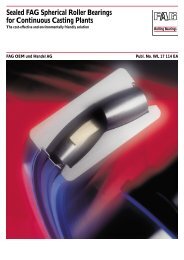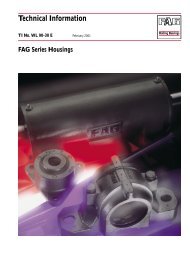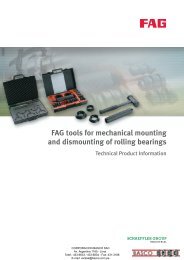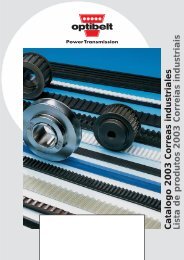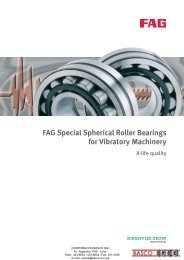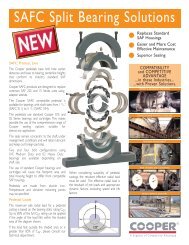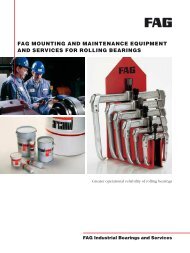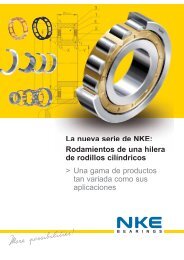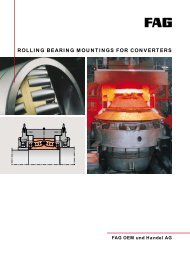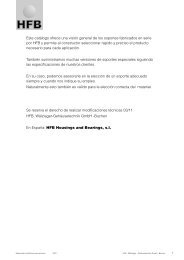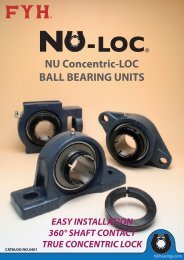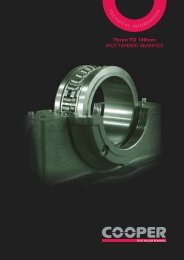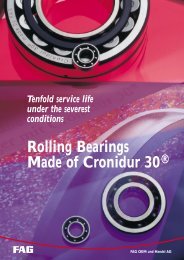You also want an ePaper? Increase the reach of your titles
YUMPU automatically turns print PDFs into web optimized ePapers that Google loves.
116 Axial piston machineCylinder block A accommodates a number <strong>of</strong> pistonsB symmetrically arranged about the rotational axis.Piston rods C transmit the rotation <strong>of</strong> drive shaft D tothe cylinder block. <strong>The</strong>y also produce the reciprocatingmotion <strong>of</strong> the pistons, provided that the rotationalaxis <strong>of</strong> cylinder block and drive shaft are at an angle toeach other.Fluid intake and discharge are controlled via two kidney-shapedopenings E in pump housing F. Bore G establishesconnection from each cylinder to openings E.During one rotation <strong>of</strong> the cylinder block, each boresweeps once over the intake (suction) and discharge(pressure) openings. <strong>The</strong> discharge opening is subjectedto high pressure. Consequently, the pistons are actedupon by a force. This force is carried by the pistonrods to the drive shaft and from there to the drive shaftbearings.D C B A GFE<strong>Bearing</strong> selectionAt relatively high speeds, bearings H and J have toaccommodate the reactions from the calculated resultantload. <strong>The</strong> bearing mounting should be simple andcompact.<strong>The</strong>se requirements are met by deep groove ball bearingsand angular contact ball bearings. <strong>Bearing</strong> locationH features a deep groove ball bearing FAG 6208,bearing location J two universal angular contact ballbearings FAG 7209B.TVP.UA in tandem arrangement.Suffix UA indicates that the bearings can be universallymounted in tandem, O or X arrangement.HJIn axial piston machines only some <strong>of</strong> the pistons arepressurized (normally half <strong>of</strong> all pistons). <strong>The</strong> individualforces <strong>of</strong> the loaded pistons are combined to give aresultant load which acts eccentrically on the swashplate and/or drive flange.Operating dataRated pressure p = 100 bar = 10 N/mm 2 ; max. speedn max = 3,000 min –1 , operating speed n nom =1,800 min –1 ; piston diameter d K = 20 mm, pistonpitch circle = 59 mm, angle <strong>of</strong> inclination = 25°,number <strong>of</strong> pistons z = 7; distance between load lineand rotational axis e = 19.3 mm.e<strong>Bearing</strong> dimensioningAssuming that half <strong>of</strong> the pistons are loaded, pistonloadF K = z/2 · p · d K2 . π/4 = 3.5 · 10 · 400 · 3.14/4 == 11,000 N = 11 kNFor determination <strong>of</strong> the bearing loads the piston loadF K is resolved into tangential component F Kt andthrust load component F Ka :F Kt = F K · sin = 11 · 0.4226 = 4.65 kNF Ka = F K · cos = 11 · 0.906 = 9.97 kN<strong>The</strong> two components <strong>of</strong> the piston load produce radialloads normal to each other at the bearing locations.<strong>The</strong> following bearing loads can be calculated bymeans <strong>of</strong> the load diagram:<strong>Bearing</strong> location JF Jx = F Ka · e/l = 9.97 · 19.3/90 = 2.14 kNF Jy = F Kt · (l + t)/l = 4.65 · (90 + 10)/90 = 5.17 kNF rJ = √ F Jx2 + F Jy2 = √ 4.58 + 26.73 = 5.59 kNFAG 166



